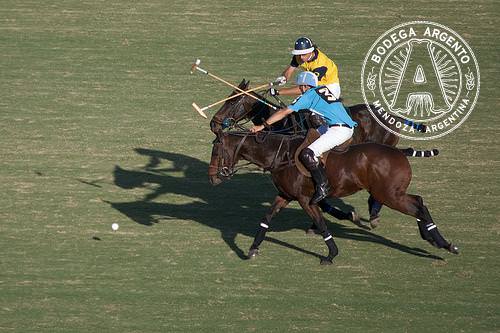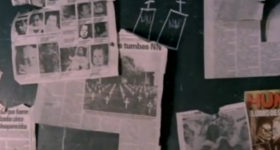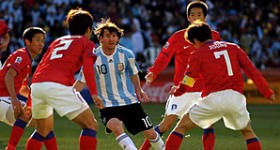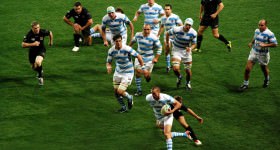Notwithstanding what happened recently in South Africa, there is one sport where Argentina dominates the world, and has done for over seventy years. Polo is a true national sport in the country and its popularity is second only to football. Championship matches in Argentina’s two biggest polo fields, in Palermo (in downtown Buenos Aires) and at the Hurlingham Club in the suburbs, attract huge crowds. During the season, games are televised almost daily.
h3. The Roots of Polo
The roots of polo go back over 2,500 years to ancient Persia where it was played by emperors with teams of up to a hundred horsemen on either side in what were essentially pitched battles. It spread throughout the East and finally caught the eye of British tea planters in India in the mid-19th century. The game was anglicised, imported to the UK in 1869, and then re-exported to the Americas and beyond.

Image courtesy of Beatrice Murch via Flickr.
In Argentina, polo was originally played on the cattle ranches, or Estancias, of British landowners. The first recorded game was at Estancia Negrete, 100 miles south-west of Buenos Aires in the summer of 1875. Before long it had spread to the capital and to the newly formed polo clubs like the Hurlingham and Belgrano.
For the first few decades, the game was played almost exclusively by English, Scottish and Irish expats, but gradually the locals joined in. Money and connections have always been part of polo, but so has skill on a horse and here the Argentines seem to have some innate natural advantage. Across the Pampas the ability to ride is bred in the bone as part of the old gaucho DNA.
h3. Pato
The gauchos themselves played a game called ‘pato‘ described as a cross between polo and basketball, though originally involving a duck. It was put in a leather basket with handles and left in a field between two villages who would each assemble a team of riders. At a given signal the teams would charge towards the terrified duck to try and bring it home to their village.
Lassoing your opponent or cutting his saddle free were perfectly legal, the only rule was that you had to ride with the pato at arm’s length to give others the chance to grab it. The game was periodically banned and the church threatened to excommunicate anyone who played it, but it has survived, albeit in a slightly tamer form. The pato has become a leather handled ball and there are now goals like large basketball hoops.
h3. The Rules of Polo
The rules of polo were laid down early on. Teams are comprised of four players and the game is divided into 8 chukkas, each seven minutes long so that horses, or ‘ponies’ as they are still called in polo, can be given a rest. The pitch is 300 yards long by 160 wide, with goals at either end.
The game was an Olympic sport in 1924 and 1936 — no prizes for guessing who won. In fact such has been Argentina’s domination of polo, many believe it won’t be returning to the Olympics any time soon. Theoretically Argentine players are amateurs at home and professionals abroad when invited to join a team sponsored by a wealthy patron (pronounced pat-rón in the Spanish style).
Like golfers, polo players are handicapped starting at -2 and rising to the ultimate of 10-goals. In championship matches a maximum handicap of 22 is set for each team. In practice this means two of the very best players (almost invariably Argentine), one of average ability and one bringing up the rear. This allows the patron to join the team and play alongside his heroes. He may not be the greatest, he may have trouble swinging his stick, but so long as he can sign the cheques everyone’s happy.
h3. Posterboy Nacho Figueras
Polo is a glamorous world judging by some of the star players like Nacho Figueras, who is also ‘the face’ of Ralph Lauren’s eponymous brand. In the newly released film ‘The Polo Kid’ (another blog post coming soon) Nacho explains the game’s allure in his lazy, Latin drawl. “Going at 35 miles an hour on a horse, heet-ing a ball, feeling the breeze on your face… Ees one of the most exciting things I can imagine!”
When interviewing the Argentine hunk on her TV show, Ophra Winfrey was clearly impressed. “In America ‘nacho’ is a snack,” she purred, eyeing him up and down. “But you’re obviously a full meal.”

Tom Bruce-Gardyne

Latest posts by Tom Bruce-Gardyne (see all)
- Own Your Piece of the Dream – Vineyard Sharing in Mendoza - August 8, 2012
- Argentina Wine Regions: San Juan - June 19, 2012
- Beyond Steak & Empanadas – Argentina’s New Wave Cuisine - March 20, 2012

 “The Polo Kid” – An Interview with Director Nathaniel McCullogh
“The Polo Kid” – An Interview with Director Nathaniel McCullogh  Polo in Argentina: You Don’t Have to be a Pro to Have a Go
Polo in Argentina: You Don’t Have to be a Pro to Have a Go  The Argentine Gaucho’s Influence on Global Fashion
The Argentine Gaucho’s Influence on Global Fashion  Classic Argentine Films
Classic Argentine Films  La Boca vs River Plate – Argentina’s Football Passion
La Boca vs River Plate – Argentina’s Football Passion  Five Emerging Talents from the Argentine Football League
Five Emerging Talents from the Argentine Football League  South America’s World Cup!
South America’s World Cup!  2011 Copa America: What’s Happened So Far
2011 Copa America: What’s Happened So Far  Messi and Maradona Lead Argentina to 4-1 Victory Over South Korea in World Cup Football
Messi and Maradona Lead Argentina to 4-1 Victory Over South Korea in World Cup Football  El Rugby: Argentina, Rugby Union & The Rugby World Cup
El Rugby: Argentina, Rugby Union & The Rugby World Cup  Argentina Hit Their Stride in World Cup 2014
Argentina Hit Their Stride in World Cup 2014  2010 World Cup Results: Argentina Loses 0-4 to Germany, Ending 2010 World Cup Football Bid
2010 World Cup Results: Argentina Loses 0-4 to Germany, Ending 2010 World Cup Football Bid
[…] better known for Eva Peron and the tango, Argentina has been a bastion of polosince the sport was popularized there by British settlers in the 19th century. China’s history […]
[…] See more at: https://therealargentina.com/argentinian-wine-blog/argentina-polo-the-classic-sport-of-argentine-… […]